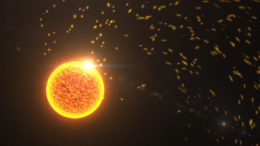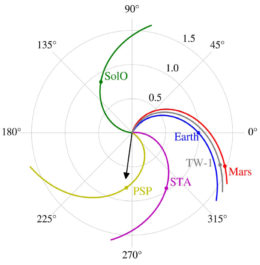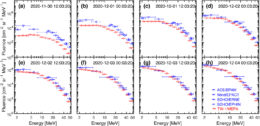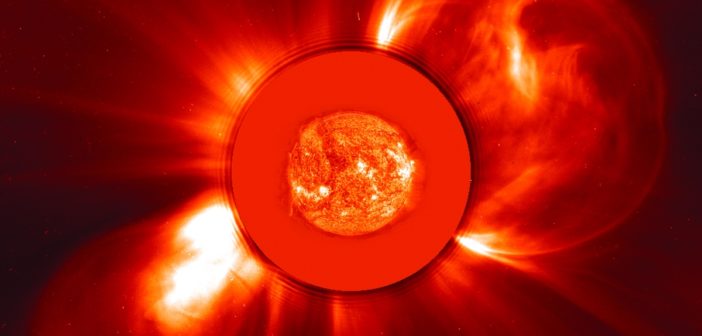A chance alignment between Earth and a Mars-bound spacecraft has given us a rare glimpse into the movement of high-energy particles from the Sun. The data from this event can help researchers understand the radiation environment near Mars — a key factor in planning crewed missions to our neighboring planet and beyond.
Energetic Particle Parade

Illustration of energetic particles being ejected by the Sun. [NASA’s Goddard Space Flight Center Conceptual Image Lab]
Spacecraft that venture out from the protection of Earth’s magnetic field must navigate this ocean of particles and weather solar storms. And if we someday wish to send astronauts to other planets, we’ll need to know how high-energy solar particles, which pose a risk to the health of astronauts and electronic systems alike, travel through the solar system.

Location of Tianwen-1 (TW-1) relative to Solar Orbiter (SolO), Parker Solar Probe (PSP), and STEREO-A (STA), Earth, and Mars. The black arrow marks the location of the active region that launched the solar storm. [Adapted from Fu et al. 2022]
When Spacecraft Align
In a new publication, a team led by Shuai Fu (Macau University of Science and Technology), Zheyi Ding (China University of Geosciences), and Yongjie Zhang (Chinese Academy of Sciences) studied the high-energy solar particles produced in an event in November 2020, when the Sun emitted a solar flare and a massive explosion of solar plasma called a coronal mass ejection.
This event coincided with a chance alignment of multiple spacecraft along the same solar magnetic field line. This alignment meant that several spacecraft near Earth and the Tianwen-1 spacecraft en route to Mars measured the same burst of energetic particles millions of miles apart, providing a rare opportunity to study how energetic particles from the Sun travel through space along magnetic field lines.
Diffusion and Evolution
By comparing the timing of measurements from Tianwen-1 to those from three spacecraft near Earth, the team discerned that the magnetic field line that connected the spacecraft did not connect back to the origin of the particles. This means that the particles must have traveled, or diffused, across magnetic field lines to reach the spacecraft.

Comparison of proton fluence (number of particles collected per unit area) measured by spacecraft at Earth (blue) and by Tianwen-1 at 1.39 au (red). The time increases from (a) to (h). The spectra at Earth and at Tianwen-1 “break” or bend at roughly the same energy, suggesting that there is little evolution as the particles travel outward. Click to enlarge. [Fu et al. 2022]
The November 2020 event marked the first solar energetic particle event observed by Tianwen-1, but surely not the last. The spacecraft will continue to monitor high-energy particles from its station in Mars orbit as the solar cycle revs up, collecting valuable data for understanding the radiation environment around Mars and planning future missions.
Citation
“First Report of a Solar Energetic Particle Event Observed by China’s Tianwen-1 Mission in Transit to Mars,” Shuai Fu et al 2022 ApJL 934 L15. doi:10.3847/2041-8213/ac80f5
